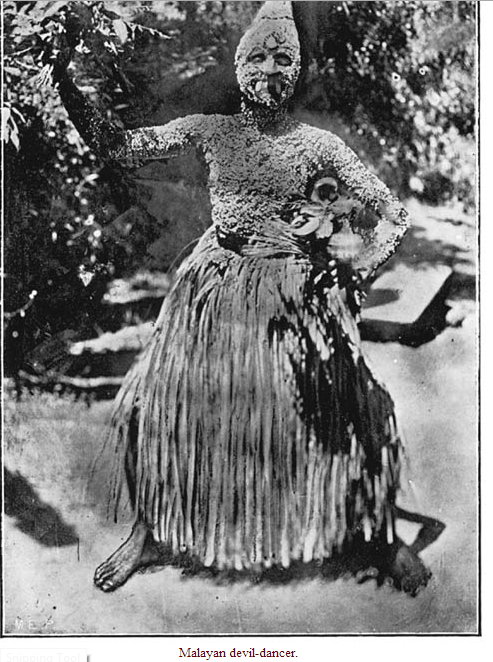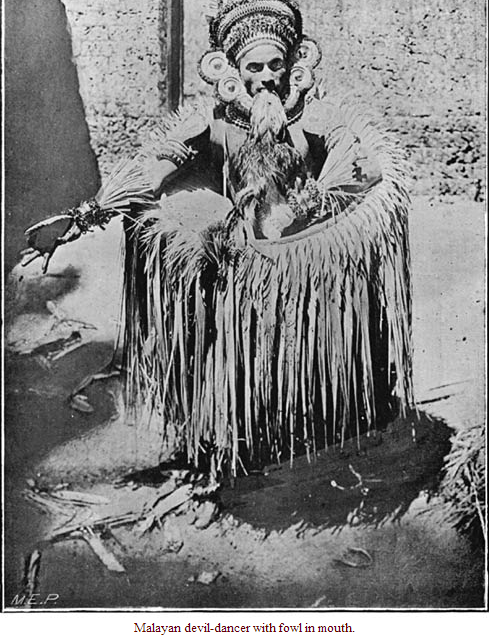Malayan
(Created page with " {| class="wikitable" |- |colspan="0"|<div style="font-size:100%"> This article is an excerpt from<br/> ''' Castes and Tribes of Southern India ''' <br/> By '' Edgar Thurston,...") |
Latest revision as of 20:21, 5 April 2014
This article is an excerpt from Government Press, Madras |
[edit] Malayan
Concerning the Malayans, Mr. A. R. Loftus-Tottenham writes as follows. “The Malayans are a makkathāyam caste, observing twelve days’ pollution, found in North Malabar. Their name, signifying hill-men, points to their having been at one time a jungle tribe, but they have by no means the dark complexion and debased physiognomy characteristic of the classes [437]which still occupy that position. They are divided into nine exogamous illams, five of which have the names Kōtukudi, Velupā, Chēni, Palānkudi, and Kalliath. The men do not shave their heads, but allow the hair to grow long, and either part it in the middle, or tie it into a knot behind, like the castes of the east coast, or tie it in a knot in front in the genuine Malayāli fashion. The principal occupation of the caste is exorcism, which they perform by various methods.
“If any one is considered to be possessed by demons, it is usual, after consulting the astrologer in order to ascertain what murti (form, i.e., demon) is causing the trouble, to call in the Malayan, who performs a ceremony known as tīyattam, in which they wear masks, and, so disguised, sing, dance, tom-tom, and play on a rude and strident pipe. Another ceremony, known as ucchavēli, has several forms, all of which seem to be either survivals, or at least imitations of human sacrifice. One of these consists of a mock living burial of the principal performer, who is placed in a pit, which is covered with planks, on the top of which a sacrifice is performed, with a fire kindled with jack wood (Artocarpus integrifolia) and a plant called erinna. In another variety, the Malayan cuts his left forearm, and smears his face with the blood thus drawn. Malayans also take part with Peruvannāns (big barbers) in various ceremonies at Badrakāli and other temples, in which the performer impersonates, in suitable costume, some of the minor deities or demons, fowls are sacrificed, and a Velicchapād pronounces oracular statements.”
As the profession of exorcists does not keep the Malayans fully occupied, they go about begging during the harvest season, in various disguises, of which that of a hobby-horse is a very common one. They further add to their income by singing songs, at which they are very expert. Like the Nalkes and Paravas of South Canara, the Malayans exorcise various kinds of devils, with appropriate disguises. For Nenaveli (bloody sacrifice), the performer smears the upper part of his body and face with a paste made of rice-flour reddened with turmeric powder and chunam (lime) to indicate a bloody sacrifice. Before the paste dries, parched paddy (unhusked rice) grains, representing small-pox pustules, are sprinkled over it. Strips of young cocoanut leaves, strung together so as to form a petticoat, are tied round the waist, a ball of sacred ashes (vibhūthi) is fixed on the tip of the nose, and two strips of palmyra palm leaf are stuck in the mouth to represent fangs. If it is thought that a human sacrifice is necessary to propitiate the devil, the man representing Nenaveli puts round his neck a kind of framework made of plantain leaf sheaths; and, after he has danced with it on, it is removed, and placed on the ground in front of him.
A number of lighted wicks are stuck in the middle of the framework, which is sprinkled with the blood of a fowl, and then beaten and crushed. Sometimes this is not regarded as sufficient, and the performer is made to lie down in a pit, which is covered over by a plank, and a fire kindled. A Malayan, who acted the part of Nenaveli before me at Tellicherry, danced and gesticulated wildly, while a small boy, concealed behind him, sang songs in praise of the demon whom he represented, to the accompaniment of a drum. At the end of the performance, he feigned extreme exhaustion, and laid on the ground in a state of apparent collapse, while he was drenched with water brought in pots from a neighbouring well.
The disguise of Uchchaveli is also assumed for the propitiation of the demon, when a human sacrifice is considered necessary. The Malayan who is to take the part puts on a cap made of strips of cocoanut leaf, and strips of the same leaves tied to a bent bamboo stick round his waist. His face and chest are daubed with yellow paint, and designs are drawn thereon in red or black. Strings are tied tightly round the left arm near the elbow and wrist, and the swollen area is pierced with a knife. The blood spouts out, and the performer waves the arm, so that his face is covered with the blood. A fowl is waved before him, and decapitated. He puts the neck in his mouth, and sucks the blood.
The disguises are generally assumed at night. The exorcism consists in drawing complicated designs of squares, circles, and triangles, on the ground with white, black, and yellow flour. While the man who has assumed the disguise dances about to the accompaniment of drums, songs are sung by Malayan men and women.
[edit] Malayan
A division of Panikkans in the Tamil country, whose exogamous septs are known by the Malayālam name illam (house).

